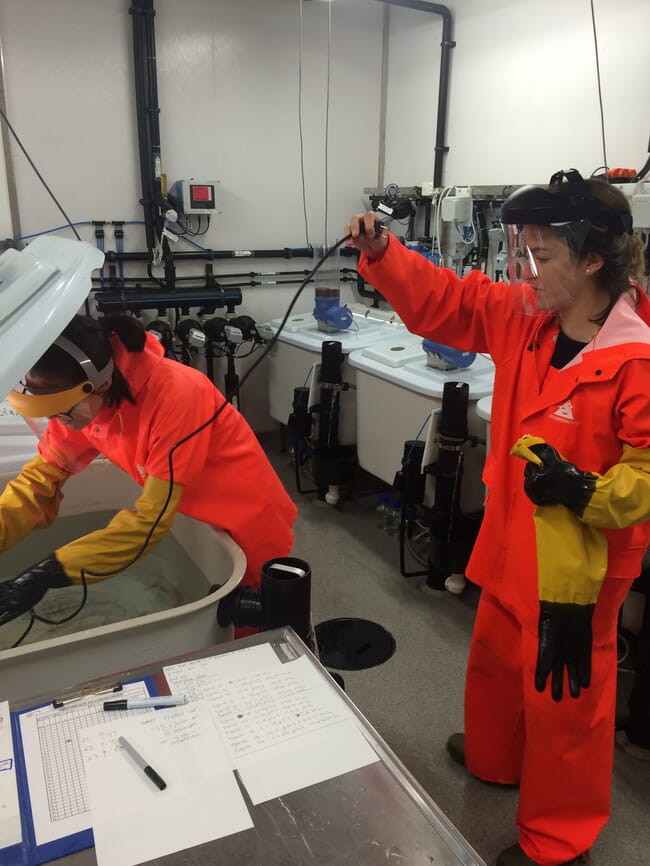Sometimes it seems like no matter how hard salmon farmers fight, sea lice always win in the end. With the parasites increasingly developing resistance to treatments like hydrogen peroxide the temptation might be to boost dosages. However, as new research from Kathy Overton (Institute of Marine Research, Norway) shows, more is not necessarily better.
Hydrogen peroxide is arguably one of the longest-running and most widely used delousing treatments employed by salmon aquaculture. Unlike other treatments such as emamectin benzoate and flubenzurons, when hydrogen peroxide hits the sea it breaks down into its natural components – hydrogen and oxygen – making it one of the most environmentally friendly solutions available. It is also one of the riskiest treatments in terms of salmon survival, but also among the most effective for delousing.
Given the risks, it may seem strange that farmers would consider upping the amount of hydrogen peroxide they expose their fish to, but the impacts of sea lice can be devastating.
“Sea lice are an important issue for salmon farmers worldwide,” notes Marine Harvest Scotland’s Steve Bracken. With the publication of their 2017 fourth-quarter report, the Marine Harvest Group announced spending reductions to cover escalating sea lice and disease treatment costs. In Norway salmon producers are required to keep sea lice levels low. Inevitably in aquaculture there are trade-offs, however, and a certain level of mortality risk may be acceptable when treatments take place.

In her experiments, conducted during her graduate studies at the University of Melbourne, Overton assessed the impacts of hydrogen peroxide concentrations ranging from 1g L−1 up to 2.25g L−1 on both sea lice removal and the salmon’s post-treatment mortality. This meant that she covered the standard range of hydrogen peroxide concentration used by industry (1.3 to 1.8g/L−1) – and a bit more. In terms of salmon mortality, the results were clear. The higher the dosage the more salmon died. At one end of the scale, concentrations of 2.25g/L−1 resulted in 100 percent salmon mortality for Overton. Clearly, industry would not even want to consider increasing their dosages this far – the trade-off is clearly not worth it. On the other end of the scale, at 1g/L−1, all of Overton’s salmon survived. At 1.5g/L−1, mortality increased up to 18 percent. At 2g/L−1 mortality rates jumped to around 60 percent. As for delousing, higher concentrations did seem to remove more lice – around 99 percent at 2g/L−1 compared to 95 percent at 1g/L−1 but this difference is not considered statistically significant.
Taking the results as they are, the temptation might be to lower concentrations to reduce salmon mortality. Sadly, the situation is more complicated. The more sea lice that survive the more chance they have to build resistance to the hydrogen peroxide – and pass that resistance onto future generations.
“At 1g per litre of treatment compared to 2g, there are 5 percent more sea lice surviving, which hypothetically would mean resistance is generated five times quicker,” Overton explained in her research. With the high salmon mortality experienced at 2g/L−1, killing off more sea lice with high hydrogen peroxide concentrations just isn’t feasible.
In an added complication, hydrogen peroxide resistance may also be built up outside of delousing protocols.
“Hydrogen peroxide plays an important role in fish health management, not just for sea lice treatments,” Bracken explains, highlighting the potentially fatal amoebic gill disease as also being treated with hydrogen peroxide. As long as the fish’s gills are in good shape and water temperatures do not exceed 14˚C, hydrogen peroxide is an effective treatment against the disease. The trouble is gill-disease treatment requires less hydrogen peroxide than delousing – around 1g/L−1. As Overton highlighted in her report: “If the fish are infected with lice when they are being treated for amoebic gill disease, we are actually giving a dose that might contribute towards resistance in lice.”
Overton’s work on hydrogen peroxide concentrations has come hot on the heels of another study in which she explored how temperature impacts salmon mortality and the efficacy of salmon delousing in hydrogen peroxide baths.
“Especially at high temperatures, hydrogen peroxide becomes more toxic to fish… previous researchers have found that the [fish] gills tend to be a bit more damaged when hydrogen peroxide is administered at higher temperatures,” she said.
Previous research has suggested that hydrogen peroxide is less effective at lower temperatures, but Overton found that using cold water baths of 7˚C rather than ambient seawater temperatures of 13˚C not only eliminated salmon mortality but was just as effective at delousing as in ambient temperatures. The reason for this, Overton suggested, is that - combined with the hydrogen peroxide - the lice simply cannot cope with the abrupt change in temperature.
As for the future of hydrogen peroxide and other chemotherapeutants, both Overton and Bracken agree that alternative solutions are needed. Marine Harvest has invested in new techniques such as cleanerfish and hydrolicers.
“Our aim is to reduce reliance on medicine use and instead continue to investigate other potential methods of sea lice control,” Bracken explains. In the long term, though, Overton’s work suggests that “we should look more towards preventing salmon from being infected by lice in the first place”.


